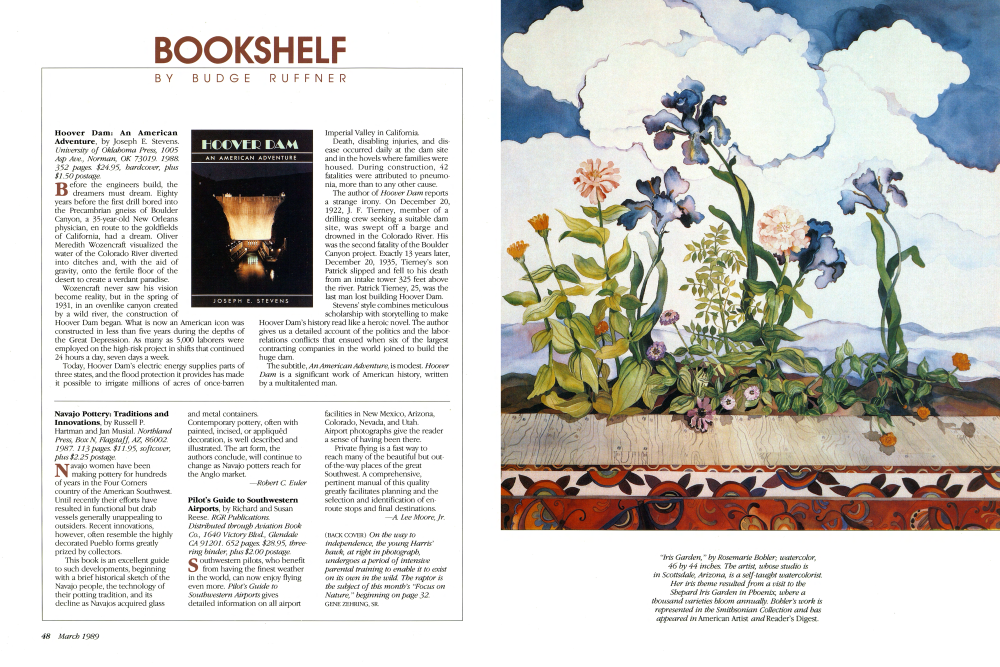BOOKSHELF

BOOKSHELF Hoover Dam: An American Adventure,
By Joseph E. Stevens. University of Oklahoma Press, 1005 Asp Ave., Norman, OK 73019. 1988. 352 pages. $24.95, hardcover, plus $1.50 postage.
Before the engineers build, the dreamers must dream. Eighty years before the first drill bored into the Precambrian gneiss of Boulder Canyon, a 35-year-old New Orleans physician, en route to the goldfields of California, had a dream. Oliver Meredith Wozencraft visualized the water of the Colorado River diverted into ditches and, with the aid of gravity, onto the fertile floor of the desert to create a verdant paradise.
Wozencraft never saw his vision become reality, but in the spring of 1931, in an ovenlike canyon created by a wild river, the construction of Hoover Dam began. What is now an American icon was constructed in less than five years during the depths of the Great Depression. As many as 5,000 laborers were employed on the high-risk project in shifts that continued 24 hours a day, seven days a week.
Today, Hoover Dam's electric energy supplies parts of three states, and the flood protection it provides has made it possible to irrigate millions of acres of once-barren
Navajo Pottery: Traditions and Innovations,
By Russell P. Hartman and Jan Musial. Northland Press, Box N, Flagstaff, AZ, 86002. 1987. 113 pages. $11.95, softcover, plus $2.25 postage. Navajo women have been making pottery for hundreds of years in the Four Corners country of the American Southwest. Until recently their efforts have resulted in functional but drab vessels generally unappealing to outsiders. Recent innovations, however, often resemble the highly decorated Pueblo forms greatly prized by collectors. This book is an excellent guide to such developments, beginning with a brief historical sketch of the Navajo people, the technology of their potting tradition, and its decline as Navajos acquired glass The subtitle, An American Adventure, is modest. Hoover Dam is a significant work of American history, written by a multitalented man.
and metal containers. Contemporary pottery, often with painted, incised, or appliquéd decoration, is well described and illustrated. The art form, the authors conclude, will continue to change as Navajo potters reach for the Anglo market.
Pilot's Guide to Southwestern Airports,
by Richard and Susan Reese. RGR Publications. Distributed through Aviation Book Co., 1640 Victory Blvd., Glendale CA 91201. 652 pages. $28.95, threering binder, plus $2.00 postage.
Southwestern pilots, who benefit from having the finest weather in the world, can now enjoy flying even more. Pilot's Guide to Southwestern Airports gives detailed information on all airport Imperial Valley in California. Death, disabling injuries, and disease occurred daily at the dam site and in the hovels where families were housed. During construction, 42 fatalities were attributed to pneumonia, more than to any other cause.
The author of Hoover Dam reports a strange irony. On December 20, 1922, J. F. Tierney, member of a drilling crew seeking a suitable dam site, was swept off a barge and drowned in the Colorado River. His was the second fatality of the Boulder Canyon project. Exactly 13 years later, December 20, 1935, Tierney's son Patrick slipped and fell to his death from an intake tower 325 feet above the river. Patrick Tierney, 25, was the last man lost building Hoover Dam.
Stevens' style combines meticulous scholarship with storytelling to make Hoover Dam's history read like a heroic novel. The author gives us a detailed account of the politics and the laborrelations conflicts that ensued when six of the largest contracting companies in the world joined to build the huge dam.
facilities in New Mexico, Arizona, Colorado, Nevada, and Utah. Airport photographs give the reader a sense of having been there.
Private flying is a fast way to reach many of the beautiful but outof-the-way places of the great Southwest. A comprehensive, pertinent manual of this quality greatly facilitates planning and the selection and identification of en-route stops and final destinations.
(BACK COVER) On the way to independence, the young Harris' hawk, at right in photograph, undergoes a period of intensive parental training to enable it to exist on its own in the wild. The raptor is the subject of this month's "Focus on Nature," beginning on page 32.
Already a member? Login ».